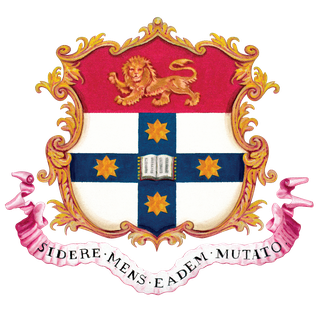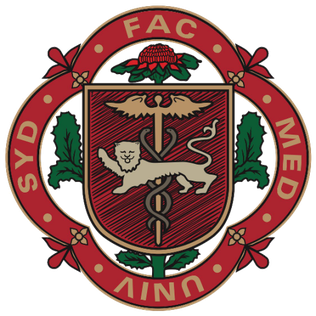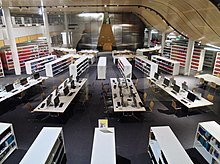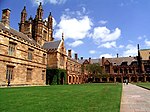
The University of Sydney (USYD), also known as Sydney University, or informally Sydney Uni, is a public research university located in Sydney, Australia. Founded in 1850, it is the oldest university in Australia and is one of the country's six sandstone universities. The university comprises eight academic faculties and university schools, through which it offers bachelor, master and doctoral degrees.

Postgraduate or graduate education refers to academic or professional degrees, certificates, diplomas, or other qualifications pursued by post-secondary students who have earned an undergraduate (bachelor's) degree.

Legal education is the education of individuals in the principles, practices, and theory of law. It may be undertaken for several reasons, including to provide the knowledge and skills necessary for admission to legal practice in a particular jurisdiction, to provide a greater breadth of knowledge to those working in other professions such as politics or business, to provide current lawyers with advanced training or greater specialisation, or to update lawyers on recent developments in the law.
The University of Toronto Faculty of Law is the law school of the University of Toronto. The Faculty's admissions process is the most selective of law schools in Canada and is one of the most selective in North America. The Faculty has consistently been ranked as the top law school for Common Law in Canada by Maclean's since it began to publish law school rankings. The Faculty offers the JD, LLM, SJD, MSL, and GPLLM degrees in law.

The University of Western Australia (UWA) is a public research university in the Australian state of Western Australia. The university's main campus is in Perth, the state capital, with a secondary campus in Albany and various other facilities elsewhere. UWA was established in 1911 by an act of the Parliament of Western Australia and began teaching students two years later. It is the sixth-oldest university in Australia and was Western Australia's only university until the establishment of Murdoch University in 1973. Because of its age and reputation, UWA is classed one of the "sandstone universities", an informal designation given to the oldest university in each state. The university also belongs to several more formal groupings, including the Group of Eight and the Matariki Network of Universities. In recent years, UWA has generally been ranked either in the bottom half or just outside the world's top 100 universities, depending on the system used. Another defining characteristic of UWA is that it has retained its Convocation as an integral part of its governance structure. All graduates of UWA are automatically life-long members of the university through Convocation which grants them the right to attend the Annual General Meetings, to elect two members of the UWA Senate and to review any changes to University legislation. Graduates of UWA include one Prime Minister of Australia, five Justices of the High Court of Australia, one Governor of the Reserve Bank, various federal cabinet ministers, and seven of Western Australia's eight most recent premiers. In 2018 alumnus mathematician Akshay Venkatesh was a recipient of the Fields Medal. As of 2021, the university had produced 106 Rhodes Scholars. Two members of the UWA faculty, Barry Marshall and Robin Warren won Nobel Prizes as a result of research at the university.

The University of Newcastle (UON), informally known as Newcastle University, is a public university in Newcastle, New South Wales, Australia. Established in 1965, it has a primary campus in the Newcastle suburb of Callaghan. The university also operates campuses in Ourimbah, Port Macquarie, Singapore, Newcastle CBD and Sydney CBD.

The University of Melbourne is a public research university located in Melbourne, Australia. Founded in 1853, it is Australia's second oldest university and the oldest in Victoria. Its main campus is located in Parkville, an inner suburb north of Melbourne's central business district, with several other campuses located across Victoria.
The University of Sydney Library is the library system of the University of Sydney. It comprises eight locations across several campuses of the university. Its largest library, Fisher Library, is named after Thomas Fisher, an early benefactor.
A Doctor of Juridical Science, or a Doctor of the Science of Law, is a research doctorate in law equivalent to the more commonly awarded Doctor of Philosophy degree.
Monash University Faculty of Law, or Monash Law School, is the law school of Monash University. Founded in 1963, it is based in Melbourne, Victoria and has campuses in Malaysia and Italy. It is consistently ranked as one of the top law schools in Australia and globally, and entry to its Bachelor of Laws (LLB) programme is highly competitive.
A Bachelor of Pharmacy is a graduate academic degree in the field of pharmacy. In many countries, this degree is a prerequisite for registration to practice as a pharmacist. Since both PharmB and PharmD are prerequisites to license in most western countries they're considered equivalent. In many western countries, the foreign graduates with BPharm, PharmB or BS Pharm practice similarly as PharmD graduates. It is analogous to MBBS vs. MD where MBBS is foreign equivalent of MD. It is training to understand the properties and impacts of medicines and developing the skills required to counsel patients about their use.
Swinburne University of Technology Sarawak Campus is the foreign branch campus of Swinburne University and is located in Kuching, Sarawak, Malaysia. Established in 2000, Swinburne Sarawak operates as a partnership between the Sarawak State Government and Swinburne Australia. The initiative behind the Sarawak campus is part of a long-term strategy by Swinburne Australia to "globalize its operations and provide its students with international living, working and learning opportunities".
The Faculty of Law and Justice of the University of New South Wales is a law school situated in Sydney, Australia. It is widely regarded as one of Australia's top law schools. The 2021 QS World University Rankings rank the UNSW Law Faculty 13th in the world, first for undergraduate law in Australia, 2nd overall in Australia and 3rd in the Asia-Pacific region, and the 2021 Times Higher Education subject rankings also rank it second in Australia, making it the top ranked law school in New South Wales according to both tables, as well as being the top undergraduate Law school in the country.

Arellano University (AU) is a private, coeducational, nonsectarian university located in Manila, the Philippines. It was founded in 1938 as a law school by Florentino Cayco Sr., the first Filipino Undersecretary of Public Instruction. The university was named after Cayetano Arellano, the first Chief Justice of the Supreme Court of the Philippines. It operates seven campuses located throughout Metro Manila and the main campus is located along Legarda Street, Sampaloc, Manila. The Arellano University School of Law is autonomous and managed by the Arellano Law Foundation. Its athletic team, the Arellano University Chiefs, is a member of the National Collegiate Athletic Association since 2009.

The University of Sydney School of Medicine, also known as Sydney Medical School (SMS) is the graduate medical school of the University of Sydney. Established in 1856, it is the first medical school in Australia. In 2018, Sydney Medical School joined the newly formed Faculty of Medicine and Health at the University of Sydney. SMS is ranked 19th in the world and second in Australia in the 2021 QS Subject Rankings for medicine.

The University of Sydney Business School is the business school and a constituent body of the University of Sydney. It was established in January 2011 and formed from the School of Business within the previous Faculty of Economics and Business. The former combined faculty itself descended from the original Faculty of Economics founded in 1920, which was the first faculty of its kind in Australia.

The University of Sydney School of Pharmacy, also known as Sydney Pharmacy School is a constituent body of the University of Sydney, Australia. The first Faculty of Pharmacy in Australia, it began teaching in 1899 with cohorts of 'Materia Medica', with the introduction of the Bachelor of Pharmacy degree itself in 1960. The school is located in its own building, the sandstone Pharmacy and Bank Building, with associated laboratories and academic staff wings below and around. The structure itself is so named because it was rebuilt on the campus grounds, piece by piece, from the facade of the then Commercial Banking Company previously located in Martin Place, in Sydney's CBD, and donated to the University in 1923.
The Sydney School of Veterinary Science is a constituent body of the University of Sydney, Australia. Initially established on 22 March 1910, it is the second oldest established veterinary school in Australia, the longest running veterinary school in Australia and one of two universities offering veterinary degrees in New South Wales. The faculty offers a joint Bachelor of Veterinary Biology/Doctor of Veterinary Medicine (BVetBiol/DVM), having retired the former Bachelor of Veterinary Science (BVSc), and the Bachelor of Animal and Veterinary Bioscience (BAnVetBioSc). The Faculty is established across both Camperdown and Camden campuses. The faculty is usually associated with the Roundhouse or Centaur as a logo and celebrated its centenary in 2010. The Faculty will be incorporated into the Faculty of Science in 2017.

The University of Western Australia Business School is a business school at the University of Western Australia (UWA). UWA first began teaching Economics in 1912, and the Business School is now home to over 4,929 students. The school has four disciplines: Accounting and Finance; Economics; Management and Organisations; and Marketing.
The University of Colombo currently has seven faculties with 41 academic departments and two interdependent schools with five academic departments. All faculties and schools carries out courses of study and research in both graduate and undergraduate studies. In addition, the university has several institutions that specialize in different areas of research.















